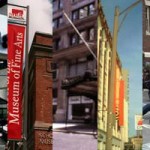Art does not die because there is no more art, it dies because there is too much.Jean Baudrillard [1]
Is there too much art? What a strange question to have to ask, and yet there are days when the answer seems to be a resounding 'yes!' Whether one looks at a small scene like Boston, or a larger market such as New York or Paris, there always seems to be just a bit more art than one can ever absorb. Is it possible that the very idea of art could be crushed under it's own weight?
In his blog, Chelsea gallery-owner Edward Winkleman points out that at the start of the fall season, "there are no fewer than 129 openings in Chelsea alone over the next 7 days." That is a vast amount of artwork to see, process, and consider. Where is all of this artwork coming from, and where is it going?
When looking at the amount of artwork showing in galleries around the globe, and certainly within the United States, it is necessary to look at the institutions that are training artists. Considering the academic system that helps artists and bestows degrees of achievement, such as the BFA and MFA, Karen Kitchel once wrote: "We can no longer justify preparing more and more graduates to compete stylishly for fewer and fewer jobs..." Her essay, titled "The M.F.A.: Academia's Pyramid Scheme" [2], appeared in the now-defunctNew Art Examiner in 1999. It garnered such a response that NAE published a response piece by Mark Van Proyen a year later titled "The Educators Educated" [3] in which he first states:
(H)er essay on the subject [...] is "right on" like nothing else published on the subject of graduate-level education in the visual arts has ever been. She accurately characterizes the state of art education as a "mess," and points to conspiracy of silence and a market-driven cynicism on the part of educational institutions as its source. The art school system shamelessly entices and processes more and more students for more and more tuition dollars, and then systematically washes its hands of any responsibility for their long-term welfare via the dubious rationale of not having made any explicit promises.
He goes on, however, to chastise Kitchel for "a case of sour grapes? Perhaps. We suspect that she would be singing a different tune if she had scored the same kind of teaching job about which her unnamed California-bound friend crows [...]". This, of course, points to a simplified version of the capitalist ideology, which states that success and failure can be attributed to personal virtue, and that those who do not have the success they desire have somehow failed morally. Yet, it could also be that the artists were led to believe that their training, and the very institution that bestowed their degree, came with certain promises that are unmet.
James Elkins writes in Why Art Cannot Be Taught [4]:
Art department fliers... usually list the famous artists who studied in their department or school. It might be more honest and thought-provoking to go ahead and list famous graduates in the college brochure, but to preface the list with a disclaimer - something like this:
Although these artists did study at our school, we deny any responsibility for their success. We have no idea what they learned while they were here, what they thought was important and what wasn't, or whether they would have been better off in jail. We consider it luck that these artists were at our school.
In general we disclaim the ability to teach art at this level. We offer knowledge of the art community, the facilities to teach a variety of techniques, and faculty who can teach many ways of talking about art. But any relation between what we teach and truly interesting art is purely coincidental.
Such a flier might add, in the interests of full disclosure:
We will not discuss this disclaimer on school time, because our courses are set up on the assumption that it is false.
Colleges induct thousands of students per year, and take vast sums in tuition dollars. Their graduates have a wide array of training and skills, and some preparation for taking on the various forms of the art world. Whether they are good or bad artists, or destined for success in a major market, no one could say -- nor would any college likely attempt to declare any one of their students 'the next great thing'. The art market is too unpredictable for that, which is why colleges love to point out their past 'successes', which Elkins happily deflates even while undercutting the very hopes that lead young artists to attempt to make careers, and the schools that help them along the way.
In a piece titled "Painting In The Red" in The Miami Herald [5], writer Dave Carpenter recently took a look at the post-graduate life of some artists, and addressed the problematic finances of one artist who had not yet found a market for his work or a source of funding related to his art:
"Van Gogh was simply broke -- he didn't have $100,000 in debt," said the 32-year-old Falkowski, who makes text paintings but works weekdays as a medical receptionist to make ends meet. "We should all be so lucky."
The point of Carpenter's article, however, is not to let Andrew Falkowski gripe about his debt. Instead, the piece talks about the Artist Pension Trust, Creative Capital and Fractured Atlas, three options for artists who need financial support for their work. These groups provide a structure for artists, so that they can live outside the grant structure, beyond gallery sales, and create work without the pressure to sell. Not surprisingly, the piece points out that "(u)nlike other countries, which give artists individual grants and will pay to send them to international exhibitions, there is no direct funding for individual artists at the federal level in the United states [...]" before stating that "(p)hilanthorpic groups and some for-profit ventures have stepped into the gap."
Just to be clear, these are organizations that are helping artists make money, have health insurance, and fund pensions. These are fundamentally excellent ideals. What is interesting, though, is that they are supporting the creation of work for which there is largely no market. The philantrhopic groups who are supporting artists are not, in fact, supporting their artwork. Instead, they are supporting the aspects of their careers that do not hinge on creativity, such as pensions and health insurance. Another way to look at it would be that the artists themselves are a market, perhaps vastly larger than their prosective employment pool (as Kitchel suggests), for whom basic needs still exist and where support can be given that is both helpful to artists and viable to businesses.
With so many artists graduating from the many art schools, colleges and other institutions each year, it seems also relevent to look at the market that will be recieving them. Looking back to Winkleman's assessment of Chelsea's 2006 fall opener, 127 openings means that at least as many artists are showing simultaneously in a single month. Boston's first weekend of the season will see around forty or fifty openings throughout the city, as well as Cambridge and the suburbs. That is a huge amount of art on the walls, and all the attention that the big fall openers bring will certainly put those artists in contact with a broad spectrum of viewers and potential buyers.
Yet, looking at some raw numbers for the Boston area, there is a pretty clear disparity between the amount of artists entering the market and the number of available venues that will sell their work. The Big RED & Shiny venues database contains about 40 galleries in eastern New England who function as commercial galleries, with sales to collectors as a primary part of their mission. In the spring of 2006, the Museum School alone graduated twenty-five artists with Master of Fine Arts degrees [6], and when combined with the other schools offering MFAs, it's easy to say that the number of MFA grads per year exceeds the number of commercial galleries in eastern New England. Thus, the surplus always exceeds the capacity, and this is before the BFA students are factored in, as well as artists who have not formally trained or move to New England from other regions. Even worse, as colleges consider adding a PhD in art, the number of formally trained artists and the variety of degrees they hold grows increasingly complex.
There are several aspects to this surplus that affect the nature of art in a region. First, competition becomes very intense. Thankfully, competition among artists tends toward making better work, more provocative or engaging or trendy work, rather than fist-fights over gallery slots. In this sense, the competition drives up the value of art in general. However, it also drives many artists away, either to another city where they perceive their chances to be better (such as New York) or out of the commercial gallery market altogether. This has led to many great alternative spaces, non-profit galleries, and similar undertakings that make the scene even stronger. Lastly, in many markets, this surplus and resulting competition drives many artists to parallel lines of work, often teaching, advertising, graphic design or other sources of income.
Returning to the original question of whether or not there is too much art, in many respects it seems that the answer is 'yes'. Art schools are producing a surplus of artists who are fighting for entry into a market that is, for the moment, very strong but still providing limited entry. Even with the recent growth of art fairs and commercial sectors in many cities, it is inevitable that most artists will not be able to build careers exclusively by selling their work.
In the other sense of the question, as Baudrillard meant it: is art crushing itself under it's own weight, destroying it's value by the sheer volume and variety available in the market?
Not yet, it would appear. As pervasive as certain trends have become, art still sits outside of the bulk of mainstream culture, and as such is not in danger of becoming the self-cannibalizing beasts that pop music, cinema or literature have become. It is the limited scope of the art market, and the inherent restrictions on the collector market, that prevent such a self-destruction. In this sense, art's restrictions are also it's safety.
There has never been a time in history when choosing to be an artist was a safe or easy career path. Most artists have probably considered the above problems at some point in their lives when looking at their options for exhibitions and jobs, and choosing which cities and schools will help them get the best start in their careers. With the beginning of the school year, it is time again to consider the scale and scope of the arts, and the sheer number of artists produced every year, and to ponder how much is too much.
Footnotes:
[1] - Jean Baudrillard, The Conspiracy of Art, published by Semiotext(e), 2005. From an interview with Geneviève Breerette, titled "No Nostalgia for Old Aesthetic Values."
[2] - Karen Kitchel, "The M.F.A.: Academia's Pyramid Scheme," New Art Examiner, February 1999.
[3] - Mark Van Proyen, "The Educators Educated," New Art Examiner, February 2000.
[4] - James Elkins, Why Art Cannot Be Taught, published by the University of Illinois, 2001.
[5] - Dave Carpenter, "Painting In The Red", The Miami Herald (via Associated Press), August 20, 2006. (thanks to Fred Levy for the tip.)
[6] - Courtesy of the office of the Registrar at The School of the Museum of Fine Arts.
Baudrillard image found here.





